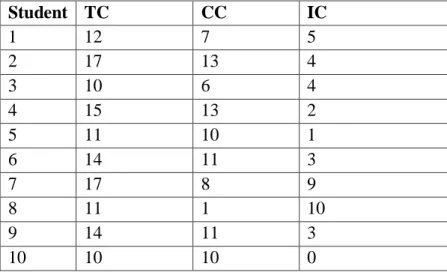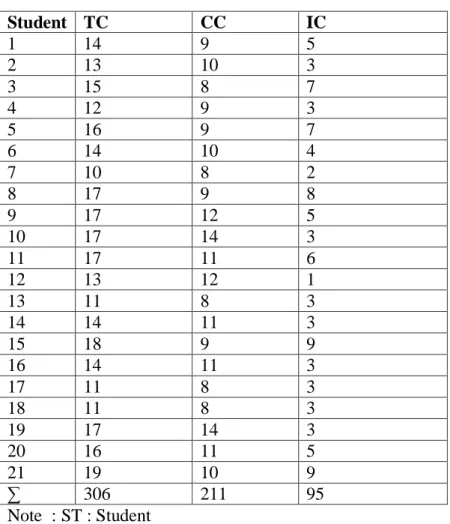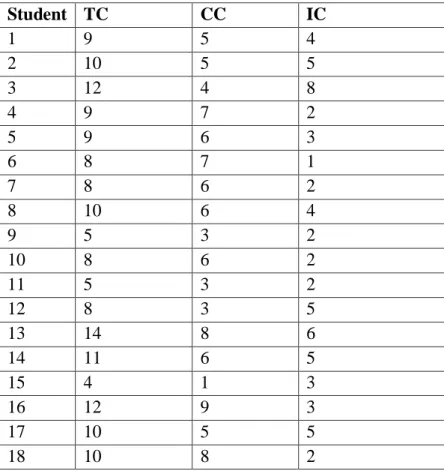My Supervisor I, Risnawati, M.Pd, and my Supervisor II, Fera Zasrianita, Thank you very much for your suggestions, corrections, and ideas during the writing process of this proposal. The ability to translate the summary from The Play Yerma written by Federico Garcia Lorca (Study in 6th semester students of TBI IAIN Bengkulu. Thus, the researcher would like to express her deepest thanks to all those who had helped her, supported and suggested it during the process of writing this proposal.
Tujuan penelitian ini adalah untuk mengetahui kemampuan mahasiswa semester enam TBI IAIN Bengkulu dalam menerjemahkan kolokasi yang terdapat pada Yerma karya Federico Garcia Lorca. Tujuan penelitian ini adalah untuk mengetahui kemampuan mahasiswa semester VI TBI IAIN Bengkulu dalam menerjemahkan kolokasi dari lakon Yermo Federico García Lorca.
- Background
- Identification of the Problems
- Limitation of the Problem
- Research Problem
- Objective of the Research
- Significance of the Research
- Definition of the Key Terms
Based on the above problem, the study's problem is formulated as follows. How is the students' ability to translate collocation from the play Yerma written by Federico Garcia Lorca. The purpose of the research The purpose of this research is: The purpose of this research is.
To discover the ability of TBI IAIN Bengkulu's sixth semester students in translating the fusion found in Federico Garcia Lorca's Yerma. As a result of the above definition, we can conclude that a collocation is a combination of at least two words that frequently occur together.
10
TRANSLATION
- Definition of Translation
- Translation Technique
- Process of Translation
- Meaning Equivalence ................................................ Error! Bookmark not defined
- Definition of Collocation
- Types of Collocation
- Translating Collocation
- Error in Translating Collocation
This means that translation is a measure of importance in the transition from the source language (SL) to the target language (TL) in the strategy method used by the translator. Adaptation replaces a social component of a type in the source language with social components that exist in the target language. This procedure can be used if the component or components of these companies have instances in the target language.
Compensation replaces the impact of data or positions in the source language in different parts of the target language because it cannot be recognized in a similar area in the source language. Description replaces the term in the source language with the description in the target language. This strategy is used when a term in the source language has no term in the target language.
Established equivalence deciphers terms in the source language that are now dominant in the target language. The term in the source language is usually based on a word reference or expression every day. This method is used when a term in the source language refers to a particular segment, corresponding to the target language that does not exist and alludes to a similar segment.
Literal translation interprets an articulation in source language into the expression of words in the target language. Modulation replaces center the perspective or the psychological angle that exists in the source language, whether lexical or basic. Compacting data should not modify the content of the message in the source language.
It is easy but difficult to assume that until a collocation can be found in the target language that conveys a similar or comparable meaning to that of the source composition, the interpreter will not be confused by contrasts in the surface design between the two. Confusion of the importance of collocations of SL can be one of the factors that are the challenges and issue in deciphering collocations and arise in the improper interpretation of the collocations in the receptor language.
Drama
- Drama as Literature and Show
Kasim (2002:37) The specificity of the drama is due to the fact that the playwright's aim does not stop only at the stage of revealing the event for the audience's connoisseurs to enjoy imaginatively, but must continue with the possibility of being staged. in a performance. Even though the drama is written with the goals being staged, this does not mean that all plays written by the author must also be staged. Certainly understanding and enjoying the literary work of the drama is more on the aspect of the story as a feature of literary works, and not as works of art.
Different dramas can be an interesting spectacle, and to become a drama that is the favorite or interest of the audience, drama must have the following characteristics: The conflict becomes an important building element in the story presented in the drama. Drama is presented to entertain the audience, but the massage or massage in the drama is also a special concern for the audience.
According to Sapardi Djoko Damono, there exist three elements that form a unity that makes drama presentable, namely the elements of the script, the elements of the performance and the audience element. Among the staging elements, there is another important part, which is composition stage, fashion, make-up, lighting, sound system, and elements of the director and actor. Dramatic text in drama discuss everything related to the text of the play that will be performed.
Marco de Marinis, gives his opinion on the relations that arise between dramatic texts and miss-en-scene, namely the realization of the text-drama turned show. He added that there is still a predilection among drama theorists to place dramatic text in a more "priority" position when it comes to embodying the dramatic text in the show, although many believe otherwise as well. In the first months of the Spanish Civil War he was shot by a nationalist firing squad.
Previous Related Studies
Lorca was instrumental in ushering in the second golden age of Spanish theater in the early 1930s. Collocation in the novel Nothing but The Truth” This research showed that: adjective and noun, noun and verb, noun and noun, verb and prepositional phrase, verb and adverb and adverb and adjective and found the dominant lexical collocation. After reading these previous studies, the researcher concludes that the first and second studies above, the researcher concludes that the first and second studies used the same theory.
The researcher used the same theory of Benson, Benson and Ilson. And they also have similarities that they are all about translating collocation. On the other hand, the similarity has also been found from the previous studies above using the qualitative descriptive method. The differences can be seen from some aspects such as in the research objective, theme and also different results with both previous studies above.
The research objective of the first previous study is to find out only the translation procedures used in the translation of English collocations in the subtitles of. Because the researcher comes from the English Education Department, the researcher not only finds the procedure that applied in the translation of collocation, but also tries to find out the students'. It is also different from the second and third previous studies conducted by Hamdi.
In this second study, the researcher discusses the application of collocation in the students' writing class and focused only on the students' writing, the differences also found in the research instrument. In the previous research, the researcher gave a writing test which is that the students write three to five paragraphs and focus only on lexical collocation, and it is similar to the third previous study by Ali Ahmad, which only focuses on what types of lexical collocation and what is. the most dominant type of lexical collocation. It can be concluded that this study differs from previous studies in research design, instruments and subjects in the research.
- Research Design
- Population and Sample
- Population
- Sample
- Data Collecting Technique
- Data Analyzing
According to Mark, a population is "the collection, all things being equal, families, gatherings, or associations, networks and events that will take an interest in the investigation. The number of population in the research focuses on the sixth semester English education study program because it depends of the curriculum of the English Department at IAIN Bengkulu, in the fourth semester in light of the fact that they learned the translation theory in the fourth semester. The researcher can use the example with the explanation if the population is excessive and impossible the research can analyze or explore each of them.
Where simple random sampling is used, the magnitude expected to reflect the population estimate of a specific variable depends on the size of the population and the degree of heterogeneity within the population. Based on the above sources of data, the researcher has used some data collection techniques for accurate and credible research. First, the researcher will send a letter/messages to the lecturer pertaining to this research and to the Head of Sixth Semester to obtain permission for a license to participate.
The researcher analyzes the collocation according to the types based on the answer to the test. The researcher calculates the length of time students spend translating collocation. The processes from Miles, Huberman and Saldana's Interactive Model will be used to analyze the data in this study (2014). And the focus of this study is on the translation of English collocations found in Federico Garcia Lorca's play Yerma.
The data obtained in this study, which consists of translating English lexical collocations into Indonesian, will be analyzed using the method of Benson, Benson and Ilson (1986). In addition to the table format, % data will be displayed to show the conclusion about the most common translation collocation used in the translation of Yerma drama. The students' score percentage from the data calculation was carried out in the scale percentage interval as below (Pedoman IAIN Bengkulu 2006).

Discussion ......................................................................Error! Bookmark not defined
Conclusion
Furthermore, many collocations were detected in the correct combinations, despite an average amount of incorrect collocations. The percentages of right collocations are also good, as shown by the results of the translation test.
Suggestion
This study only examined the use of lexical conjunctions, adverb + adjective, noun + verb, verb + noun, and verb + adverb, according to the researchers. As a result, we can have a clearer and more complete understanding of how collocations are used. 1975), Introduction to Qualitative Research Method – A Phenomenological Approach to the Social Sciences, New York: John Wiley and sons.
Translation of English to Indonesian summaries in the subtitle of "Ethel & Ernest" Journal of Literature.


